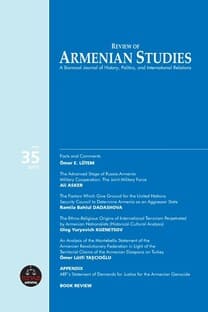TÜRK DÜŞMANLIĞI’NIN BİR BAŞKA YÜZÜ: DÜNYA ÜZERİNDEKİ “SOYKIRIM” ANITLARI
Ermeni, anıt, yazıt, tarihsel hafıza
A DIFFERENT DIMENSION OF TURCOPHOBIA: “ARMENIAN GENOCIDE” MEMORIALS IN THE WORLD
Armenian, monuments, inscriptions, historical memory,
- ISSN: 1303-5304
- Yayın Aralığı: 2
- Başlangıç: 2002
- Yayıncı: Terazi Yayıncılık Basım Dağıtım Danışmanlık Eğitim Organizasyon Matbaacılık Kırtasiye Tic. Ltd. Şti.
Notes from the battlefield known as'history'
Intra-or international violence? the origins of armenian terrorism
TÜRK DÜŞMANLIĞI’NIN BİR BAŞKA YÜZÜ: DÜNYA ÜZERİNDEKİ “SOYKIRIM” ANITLARI
MİLLİYETÇİ BAKIŞ AÇILARININ NEDEN OLDUĞU YANILSAMALAR VE ERMENİ İDDİALARI
A different dimension of turcophobia: "Armenian genocide" memorials in the world
ERMENİ SOYKIRIMI TEZLERİNİ ELEŞTİREN İLK AMERİKAN AKADEMİK KİTABI
Turkey and armenia: the need for compassion with common sense
Armenia's foreign policy: Small state irredentism
